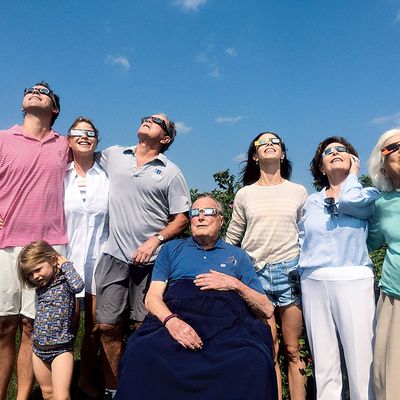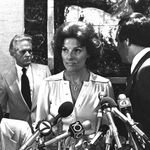
This piece was originally published on November 14, 2017. It has been republished following George H.W. Bush’s passing.
The rehabilitation of George W. Bush has never looked more promising. His recent speech in defense of the Republicanism of yesteryear (free trade, globalization, and multinational alliances) came loaded with “Never Trump” alarms about the rise of “bigotry” and “nativism,” “conspiracy theories” and “outright fabrication.” It pleased even Democrats, who not long ago loathed him almost as much as they loathe Trump — and did so, at least by the end of Bush’s second term, with more concrete reason: a needless and costly war in Iraq, an incompetent and coldhearted handling of Hurricane Katrina, Wall Street–first economic policies that plunged the economy into the Great Recession.
And yet today, remarkably, much is being forgiven. Why? For one thing, Bush’s “compassionate conservatism” was sincerely meant and has yielded results. Bush himself continues to promote health-care initiatives in Africa to fight AIDS and provide cervical-cancer screening. For another, although, like Trump, Bush came to the presidency underprepared, unlike him, he proved a diligent student in the White House. It is hard to imagine Trump reading 14 books on Lincoln, as Bush did while he was president.
It isn’t just W. The entire Bush clan now wears a fresh glow. Bush’s father — “41” to W.’s “43,” in their helpful self-designations — has been basking in adulation for some years. Forty-one was our most recent one-term president, sent packing with a smaller share of the vote than any incumbent since Taft, under 38 percent — about the same as Trump’s approval rating after his party’s drubbing in Virginia. But in Jeffrey A. Engel’s new book When the World Seemed New: George H.W. Bush and the End of the Cold War, the diplomatic historian argues that, contrary to most opinion, including Bush’s own in a rueful moment, he really did possess the “vision thing” and used it to guide the country and the Western democracies during a hazardous time: that of the collapse of a rival superpower, the Soviet Union. “Never before in human history had a great power broken apart with more than twenty thousand nuclear weapons in its midst,” Engel writes. “There were no helpful precedents” for Bush to follow, he adds, “and no guarantees it would all end well.” But it did end well, in part owing to the “prudence” Bush was mocked for in his day — the same prudence that led him to reverse his “Read my lips” policy on taxes and instead compromise with Democrats. That tax hike was assisted political suicide — Newt Gingrich and Pat Buchanan gleefully pushed him along — but it was also the right call.
Even Barack Obama has praised 41’s low-key, sensible approach to both foreign and domestic policy (“thoughtful, restrained, and made good decisions”). More recently, Bush Sr. was wheeled onto the field at the Super Bowl and got an ovation when he tossed the coin at the 50-yard line. At age 93, with his old man’s permanent rictus, he’s even weathered reports of groping incidents.
This is all further evidence that the Bushes do indeed personify the old days, at least to the many suddenly, and feverishly, pining for them. But the wheel has turned in the Bushes’ favor not through mere accident or kindness of history. A good deal of image-burnishing has gone on — deftly, too. However clumsy the Bushes may seem, they are well schooled in the upper-class art of making self-promotion seem a concession to public demand, in the bashful spirit of Jackie Kennedy’s televised tour of the White House. Thus, the likable twin daughters, Jenna Bush Hager and Barbara Pierce Bush, almost 36, in their newest book, Sisters First, overshare childhood “stories from our wild and wonderful life” that aren’t stories at all but lightly served-up trivia: Jenna’s first kiss (in fourth grade, “during a game of spin the bottle”); Barbara’s musical favorites (“Paul Simon’s classic album Graceland was released when Jenna and I were in first grade”). Devotees will note as well the recycling of Jenna’s letter to Dad volunteering to work on his reelection campaign, which was previously published at full length in W’s memoir, Decision Points. They will note, too, the foreword by Laura Bush, who also provided one for Portraits of Courage, her husband’s book of oil paintings of some five dozen badly wounded survivors of his wars of opportunity in Iraq and Afghanistan.
Presidents, as Trump forcefully reminds us with each tweet, are the monarchs of our democracy, including the ones we turn against. After long years of banishment, even Herbert Hoover had his moment, becoming a good friend of Harry Truman’s, himself a once-despised figure who has been rehabilitated. Lyndon Johnson, hounded from office because of Vietnam, has since risen as the legislative maestro of the civil-rights era. Now it is the Bushes’ turn. Everything we once rejected looks different. The Skull and Bones elitism and Establishment presumptions now remind us of tradition — of the Wise Men and their internationalist worldview, American grown-ups who belong on the world stage. For all our talk of anti-elitism, we prize — even protect — our elites. And the odd Bush mix of Greenwich clubbiness and Sun Belt yahooism, which often seemed so phony, now looks like an attempt to bridge old and new America, to unite rather than divide, as George W. Bush liked to say. In the alienating age of Trump, the Bushes seem comforting — more like the country we used to be and, in some ways, at least, wish we were again.
The country’s appetite for that rehabilitation has been fed by a growing shelf of hagiographies. Mark Updegrove’s new addition to the dynastic library, The Last Republicans, has the feel of an inside job and includes just enough father-and-son bashing of Trump to have kindled prepublication interest. In our post–Game Change world, it is newsworthy that neither Bush voted for Trump. (Did anyone imagine otherwise, after his brutal dismantling of Jeb Bush, the “45” who wasn’t to be?) Bush 41’s epithet for Trump (“blowhard”) and 43’s aghast reaction (“Wow, this guy really doesn’t understand the job of president”) both got coverage from the Times and Stephen Colbert, not to mention an irked rejoinder from the White House, which reminded us, accurately enough, that the Iraq War was “one of the greatest foreign-policy mistakes in American history.”
Updegrove argues that the two Bush presidents were more alike than many suppose, rather like the almost equally unpopular Adamses, John and John Quincy. He’s right, especially when it comes to the Iraq invasions, both undertaken with the same blind fervor and executed with the same disregard for the rule of law and democratic norms — excesses that we do well to remember were not invented by Trump, who has yet to plunge us into war of any kind, let alone one that helped destabilize an entire region and probably bred a new generation of jihadist fanaticism for which we have no good answer.
The Middle East is as it is today because of the Bushes. The first Iraq invasion has been enshrined as a model of foreign policy — but only because the second one was so much worse. In fact, doubts attended 41’s invasion, too. One of that war’s few candid memoirists, Colin Powell, later described a period of bungled signals, beginning when the ambassador in Baghdad assured Saddam Hussein, on Bush’s orders, that the administration had “no opinion on the Arab-Arab conflicts like your border disagreement with Kuwait.”
In some 100 articles, many of them written by Douglas Frantz, the L.A. Times gradually peeled away the story behind the war: Saddam had been our client for years, supported with loans, including $5 billion laundered via the Atlanta office of an Italian bank, for which the payments were still being disbursed until shortly before the war. The administration frantically covered this up, through a farrago of falsified documents and opaque testimony in congressional hearings. “That Bush has lied about his knowledge of shipments of U.S. arms to Iraq can no longer be seriously disputed,” wrote the Washington Post columnist Jim Hoagland.
William Safire, the period’s most respected conservative columnist, later wrote in the New York Times, “The war in the Persian Gulf was brought about by a colossal foreign-policy blunder … the Bush administration’s fraudulent use of public funds, its sustained deception of Congress and its obstruction of justice.” The chairman of the Senate Intelligence Committee, David Boren, a moderate Democrat from Oklahoma, called for a special prosecutor, so thick had the atmosphere grown with disinformation and stonewalling by the CIA and the Justice Department. Nevertheless, “Iraq-gate” was “unraveling with stunning speed as the Bush administration dissolve[d] into warring clans more worried about staying out of jail than promoting the reelection of President Bush,” Hoagland wrote three weeks before Election Day in 1992.
The actual battle for Iraq lasted only 42 days, in January and February of 1991, but as the L.A. Times summarized, the successes there were oversold, too:
U.S. “smart bombs” weren’t really so smart. Iraq’s mobile Scud launchers weren’t really destroyed in large numbers. There were far more civilian casualties in Baghdad than the Pentagon had acknowledged during the war. Gen. H. Norman Schwarzkopf was admittedly “suckered” in failing to ban Iraqi helicopters from the skies immediately after the war, thus enabling Hussein’s forces to massacre thousands of Kurds.
With this we come to the essence of Bushism and its literature, as concocted by the Bushes and their advocates, who include not only Updegrove but Jon Meacham, whose giant hagiography of Bush 41 includes not one word on Iraq-gate and barely mentions Bush’s role in Iran-Contra. Both biographers subscribe to what seems a Trump-inflected “good man” theory, or fable, of American history. Its unstated premise is that American greatness is long gone, and what beckons in its place, if only we’ll receive the message, are the rock-solid cardinal virtues personified by the Bushes.
Not quite Adamses, Roosevelts, or Kennedys, the Bushes are Everyman patricians — in Updegrove’s telling, “emblems of decency and public service,” shepherds of “humanitarian concern,” ennobling missions pursued without ego or a sense of personal glory. Bush 41, smarting from his thrashing by Bill Clinton, consoled himself that he could leave office confident no one “can lay a glove on me in the final analysis on serving without conflict; never for personal gain.” This ethos is indeed gone, because it is rooted in the presumption that privilege automatically confirms superiority: Only the wellborn or well connected can truly say they bypassed the lucrative private life, which they can still have whenever they wish. To the rest of us, choosing to run for high office might seem the pathway to power, no less a lure than easeful riches. But to the patrician, it means sullying oneself. That is why they keep around thugs and heavies — Lee Atwater, Karl Rove — to do the nasty political work.
This is the darker side of “humility,” a word that appears four times on a single page in The Last Republicans when the subject is Trump. He keeps failing the humility test, which Bush 43 says begins in “recognizing your limitations and surrounding yourself with people who know what you don’t know.”
This formulation will surprise anyone who remembers the second Iraq War and Bush’s own brazen disregard for opinions that came from outside the closed curia of his war room — or recalls Bush’s swaggering speech at the U.N. a year and a day after 9/11. With Trump-like belligerency, Bush described a “world of fear and a world of progress,” warned other nations they must not “stand by and do nothing while dangers gather.” Bush later said he “did the U.N. a favor” by addressing it. “It didn’t occur to him … that this might not feel at all like a favor — a mighty, fabulously privileged country telling lowly nations how and when they must act,” as Robert Draper wrote in Dead Certain, the best early account of the Bush White House, published in 2007.
It also “didn’t occur to Bush to step outside his own skin,” Draper wrote. Bush 41, too, had trouble with empathy, privately stewed over the labels pasted on him: “cold-hearted,” “disconnected,” “not caring about people.” What Bushes do care about is loyalty, being on the team, carrying out the mission. Long before either Bush was elected president, Graham Greene captured their particular type in The Quiet American, his frighteningly prescient novel about Vietnam. The American, Pyle, moves in a world of covert actions and inhabits a cave lit by the radiance of his certitude — “a psychological world of great simplicity, where you talked of Democracy and Honor without the ‘u,’ as it’s spelt on old tombstones, and you meant what your father meant by the same words.” It is this idea that led both Bushes on their mission not to make America great again but to make the world good in the American image, through “shock and awe” if need be. After 9/11, Bush, who had been foundering, looking for a big mission, now had one.
How clearly he can see the legacy of that mission now is hard to say, he has been living so fully in retreat — though not quite shame — since 2009. Returned to his — highly lucrative — private life, Bush 43 has become a Croesus of suffering, surrounding himself with the “warriors” whose lives, shattered by Iraq and Afghanistan, he has tried to rebuild through the organizations he set up after leaving the presidency. Americans first learned of his retirement hobby when the hacker Guccifer leaked bathroom scenes Bush had painted, many of himself. But Bush, we soon learned, was a genuine portraitist, a surprisingly attentive watcher of others. The first subjects were world leaders, but as his technique has improved, he has turned to richer, more ambiguous material — the damaged survivors, some just barely surviving, of Bush’s own wars of choice. The ritual has the shape of penance, but the work itself points us back, inescapably, to the painter. The portraits are exercises, finally, in self-rehabilitation. This, too, is a patrician trait: They alone have the power to judge and absolve, even when the misdeeds are their own.
Portraits of Courage includes thumbnail biographies of each subject — a grim résumé of injuries, surgeries, rehab. “Tim spent the next four and a half years in and out of hospitals, undergoing nearly fifty surgeries,” Bush writes of one in the tone less of an anguished commander-in-chief than an interested sideline spectator. In earlier wars, he and many would probably have died on the battlefield or in the operating room. That “only” some 7,000 American military personnel were killed in Afghanistan and Iraq is a testament to modern medical science. The more telling number, in any case, is the 970,000 disabled in some way by the war. Bush can’t possibly paint them all. The “last Republicans” are our House of Atreus, the curse passed from father to son — the dark bloom planted all those years ago in the Iraqi desert. Only in America could guilt so deep still wear the look of idealism. Such innocence, as Graham Greene said, “is a kind of insanity.”
*This article appears in the November 13, 2017, issue of New York Magazine.





























